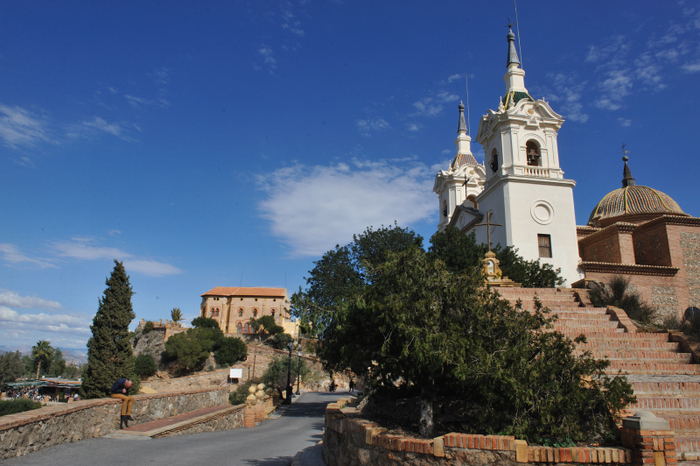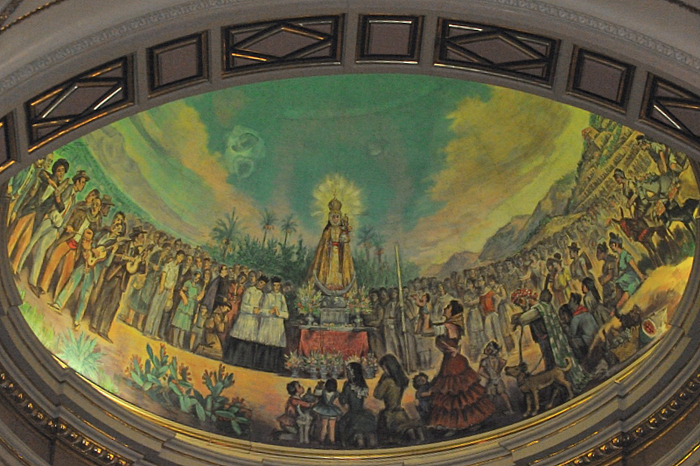

- EDITIONS:
 Spanish News Today
Spanish News Today
 Murcia Today
Murcia Today
 Alicante Today
Alicante Today
Santuario de Nuestra Señora de la Fuensanta in Algezares, Murcia
The mountain sanctuary of the patron of Murcia, the Virgen de la Fuensanta
One of the most popular days out among residents of the city of Murcia, and one which is highly recommended to visitors to the Region, is to take the car and head for the hills to the south of the city, where dense pine forests offer a refreshingly cool change from the heat which can gather in the valley below.
Among the highlights of a visit to the hills of the Sierra de Carrascoy and the El Valle area is the Santuario de Nuestra Señora de la Fuensanta, which for most of the year is home to the patron of the city of Murcia, the Virgen de la Fuensanta (or “La Morenica” as she is often affectionately known by locals). Many Murcianos (mainly those who can afford to!) choose this church as the perfect venue to get married, with the panoramic views out over the city offering an almost unmatched backdrop, and even those with no special occasion to warrant visiting the church often gravitate to this area and to the café-bar alongside to enjoy viewing Murcia from a distance.

The sanctuary stands on the edge of the Carrascoy y El Valle regional park and is a great place from which to set out on a hike through the woods: it is also close to the El Valle and La Luz visitor centres.
Admission to the Santuario is free of charge for the public every day from 9.00 to 13.00 and 16.00 to 18.30, with Mass being held from Monday to Friday at 18.00. On Saturdays Mass is at 17.00, and on Sundays and religious holidays at 10.00, 12.30 and 17.00.
During summer Mass times are 9.00 Monday to Friday, 19.00 on Saturday and 11.00 and 19.00 on Sundays and religious holidays.
History of the Santuario de Nuestra Señora La Fuensanta
The Santuario de Nuestra Señora La Fuensanta dates from the late 17th century, but the site is known to have been occupied by other religious buildings before then. Documentary information from the year 1429 mentions a small place of worship in a cave which was looked after by some of the religious hermits who lived in the mountain caves which are dotted around on this hillside. Evidence of this kind of occupation still survives in the “Cueva de la Cómica”, among others: this was occupied by Francisca de Gracia, who was a successful comic actress in Madrid before abandoning the high life in 1610 and inhabiting the cave while devoting the rest of her life to taking care of the Virgen de la Fuensanta.

It seems possible that the holiness of the location was a remnant from the far earlier religious constructions built by the Iberians before Christ was even born at the Santuario de la Luz nearby at La Alberca, and throughout Roman and Moorish occupation the area appears to have retained its spiritual importance.
In 1598 the building at La Fuensanta was placed in the hands of Isidro de Lorca and a stone staircase was added, and there is evidence of plans to restore the small hermitage in both 1629 and 1664, but construction of the current Santuario did not begin until 16th February 1694.
At this time that there was much debate in Murcia over the issue of whether the “Patrona” should be the Virgen de la Arrixaca, who had been named as such by Alfonso X in the 13th century, or the Virgen de la Fuensanta. Many hold that this debate was effectively resolved in 1694 when a long drought came to an end after the Romería de la Fuensanta, (a Romería being the occasion on which an image is transferred from one place to another, an act of religious reverence) the heavens opening immediately afterwards and saving the crops, a circumstance which was repeated on various occasions before La Fuensanta was finally named patron in 1746.
La Morenica is carried in Romería back and forth from Murcia twice a year, and its a thoroughly enjoyable occasion in which to participate.
In February 1694 Juan Antonio La Riva noted that the first steps were taken to level out the ground on which the new church was to be built, and work continued apace over the following years. The result, after many modifications over the intervening centuries, is a baroque-style church with a series of side chapels and a large dome over the transept. The main façade was designed by Toribio Martínez de la Vega (who also created the Puente de los Peligros in the city of Murcia) and Jaime Bort, who was responsible for the main façade of the cathedral of Murcia. The original altar-screen and camarín niche were lost in the Civil War, were by Antonio Dupar, and were replaced by Antonio Carrión Valverde and Nicolás Prados López.
The towers were restored by Rafael Castillo Sáiz and Pedro Gil García in 1925 and 1926, but not long afterwards during the Civil War the interior was completely ransacked, and this led to the last main renovation of the building in the mid-20th century, supervised by the architects Eugenio Bañón Segura and Damián García Palacios. At the same time the Benedictine nunnery which stands alongside was also built by Fernando Garrido.

Visiting the monument
The exterior
The main façade of the Santuario de la Virgen de la Fuensanta, which was designed by Toribio Martínez de la Vega in 1705, features two angels with trumpets holding the heraldic shield of the cathedral chapter of Murcia over the main door, and the figure of the Virgen herself is by Jaime Bort. Next to her are San Fulgencio and San Patricio, the patron saint of the city and old Kingdom of Murcia.
At the top of the façade is a wrought iron cross, and the whole is framed by the two towers which were replaced in the 1920s.
In the area around the sanctuary are various other constructions, including the Fuente Santa (Holy Fountain) which originally gave rise to the worship of Fuensanta many centuries ago. The Benedictine nunnery stands alongside the church, and the Casa del Cabildo (chapter-house) stands around 100 metres away on a small rise.

The interior
Apart from admiring the outside of the Santuario and the views out over the Segura valley and the city of Murcia, there are also a number of noteworthy features inside the building.
The most important of these is the statue of the Virgen de la Fuensanta herself. The origins of the painted wooden figure, which measures 1 metre 43 centimetres in height, are uncertain, but according to Roque López, one of Salzillo’s most admired followers, who restored her in 1802, she may date back to the 15th century.
She wears a tunic, a long shawl, a silver crown and other facial adornments. She also carries a staff of command which was awarded to her on 27th May 1808, when she was named General of the Troops of Murcia in the face of the invasion by Napoleon’s troops during the Peninsular War.
The figure’s eyes are fashioned from glass, and La Fuensanta has thick black eyebrows and eyelashes, while her nose and lips are thin.
The Infant Jesus, on the other hand, has fine blond eyebrows. The figure’s author is not known, although local tradition has it that the infant is the work of Francisco Salzillo. The baby is giving a blessing with his right hand, while in his left he holds a globe which symbolizes the Earth as an allusion to Redemption.
The figure of La Fuensanta was originally kept in the cathedral of Murcia, where it was known as the Virgen de las Fiebres, but was later taken to the Santuario having been renamed by Bishop Trejo. The plinth on which she stands is decorated with a cherub and two angels, and a half-moon was added by Antonio Carrasco in the late 19th century.
For many the other most eye-catching feature is the painted mural decoration on the inside of the dome and the choir by Pedro Flores, which dates from the 1950 renovation and features various murals depicting Murcia and its history.
The dome has a diameter of 8 metres, and the main motif represented here by Flores is the glorification of the Virgen de la Fuensanta during a typical Romería attended by some of the most glorious figures from Murcia’s past. These include King Alfonso X (“The Wise”), the Conde de Floridablanca, the sculptor Francisco Salzillo, the painters Pedro de Orrente and Nicolás de Villacis and Cardinal Belluga, all of them joining in with more everyday figures such as the Auroros, typical huertanos, clergymen, Moors, the throne of La Fuensanta, Nazarenes, mules and various others, with the city of Murcia and its emblematic cathedral as a backdrop.
The mural in the choir shows a stylized version of the canonization of the Virgen de la Fuensanta, which was performed on 24th April 1927 in Murcia by Monsignor Tedeschini (representing Pope Pius XI).
While the mural in the choir is generally viewed as being more colourful, both are images of joy and celebration, and they capture well the atmosphere in Murcia during the Semana de Primavera and the second week of September, which is when the hugely popular Romerías accompany the Fuensanta back to the Santuario after her twice-yearly visits to the Cathedral in Murcia.
Unfortunately the magnificent altarpiece and the camarín niche behind it, which were the work of Marseille sculptor Antonio Dupar in 1772, were victims of the pillaging during the Spanish Civil War (1936-39), and the altar-screen which can now be seen was created in the 1950s by Nicolás Prados López. The four Corinthian columns feature highly decorated entablatures and impressive friezes, while the new camarín niche is the work of Antonio Carrión Valverde and Juan González Moreno. Ten relief sculptures by González Moreno show different scenes from the life of the Virgin Mary, including The Flight from Egypt, the Nativity, the Birth of the Virgin, The Dream of Saint Joseph, the Visitation, The Annunciation, the Marriage of the Virgin, the Coronation, the Presentation of Jesus in the Temple and the Adoration of the Magi.

External area
There is plenty of parking next to the sanctuary, and the magnificent views across the valley floor below can be enjoyed from the cafeteria on site. This is a popular starting point for a walk leading out of the back of the sanctuary and following the course of the road up past the hermitage of La Luz where chocolate can still be purchased from the monks living there today, and on to the La Luz visitor centre containing an interesting exhibit relating to the Iberian sanctuary which once dominated this hillside as well as traditions of the Murcia Region. The visitor centre also has a large restaurant above it giving suberb views of the surrounding countryside.
Surrounding all of this is the magnificent park, with plenty of walking options and areas in which to sit and enjoy the shade from the hot sun.
From the main motorway follow the signs for La Alberca. The turning for the sanctuary is at the entrance to Algezares and is a sharp right turn, which isn´t brilliantly signposted.
Click for map, Sanctuary of La Fuensanta




































